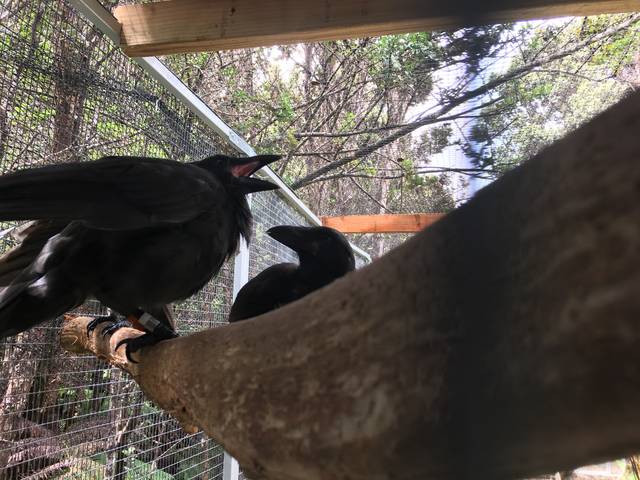HILO — Six youngAlala — critically endangered Hawaiian crows — were released Wednesday into Puu Makaala Natural Area Reserve on the Big Island.
The first group of birds: two females and four males took some time to emerge from the aviary where they had been temporarily housed and they appeared to show a natural curiosity for their surroundings. Plans are to release a second group of five birds: two females and three males in mid-October from the same release aviary.
Previously, in December, a reintroduction attempt was halted after challenges posed by winter storms and predation on Alala by Io, (Hawaiian hawk). The concerted reintroduction efforts, funded by the state Department of Land and Natural Resources, San Diego Zoo Global, and U.S. Fish and Wildlife Service have addressed those challenges by changing the timing of release to avoid winter storms, changing the release site location, releasing a social group of both males and females, and enhancing the “antipredator training program” to teach the released birds how to better respond to predators like Io.
A high mortality rate is associated with releasing species into the wild. This is especially true for species like Alala that have been in captivity for longer periods of time. A successful conservation breeding program gives managers the flexibility to adapt their management techniques to improve successful transition to the wild. Conservation breeding programs are key tools for recovering threatened and endangered species.
For example, the nene, or Hawaiian goose, has returned from the brink of extinction thanks to an intensive breeding program and the dedication of many partners over decades, and this species still requires active management and monitoring. For Alala, these continued efforts are also essential to the species’ recovery.
Nine of the 2017 release birds were moved to a flight aviary in early 2017, to allow them to acclimate to the sights and sounds of the Hawaiian forest, and to socialize them with the two males that survived the December 2016 release. They were then transferred to a smaller aviary in the forest two weeks prior to the release. Puu Makaala Natural Area Reserve is an area that conservationists of the Three Mountain Alliance and DLNR have worked for decades to preserve, protecting native plants and species, and it represents a type of high-elevation habitat whereAlala originally lived before their numbers began to decline.
The Alala, or Hawaiian crow, has been extinct in the wild since 2002, preserved only at the Keauhou and Maui Bird Conservation Centers managed by San Diego Zoo Global’s Hawaii Endangered Bird Conservation Program. With more than 125 individuals of the species at the centers, conservationists are ready to return the birds to their native forests. Alala are an important part of the life of the Hawaiian forest, as they eat and assist with the dispersal of native plant seeds.
“Recovering threatened and endangered species takes dedicated partnerships like TheAlala Project,” said Michelle Bogardus, U.S. Fish and Wildlife Service Geographic Team Leader for Maui Nui and Hawaii Island. “We will continue to work with our partners to protect and recover Hawaii’s threatened and endangered species.”
DLNR Chair Suzanne Case commented, “This has been an ongoing learning process for everyone, to get it right for theAlala to learn the skills they need to survive. The entire project highlights the benefits of protecting habitat and addressing threats such as predators, disease, and invasive species before populations decline so rapidly that recovery becomes even more challenging.”






